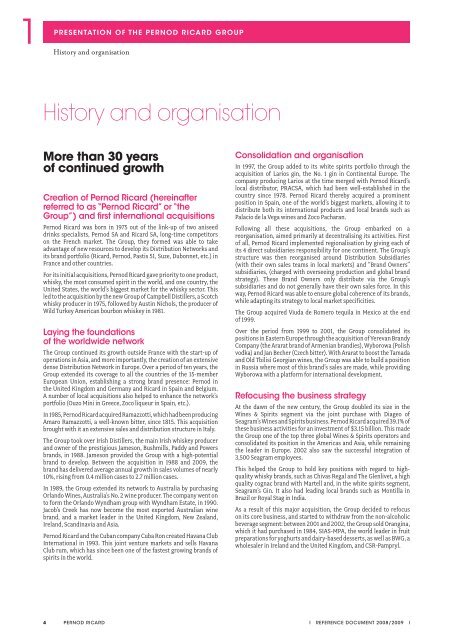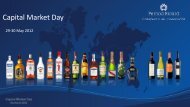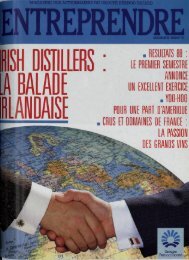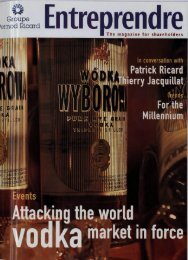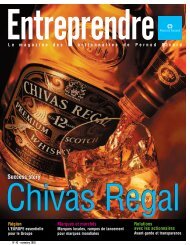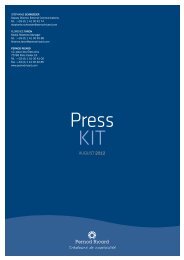Registration Document - Pernod Ricard
Registration Document - Pernod Ricard
Registration Document - Pernod Ricard
Create successful ePaper yourself
Turn your PDF publications into a flip-book with our unique Google optimized e-Paper software.
1 History<br />
4<br />
PRESENTATION OF THE PERNOD RICARD GROUP<br />
and organisation<br />
History and organisation<br />
More than 30 years<br />
of continued growth<br />
Creation of <strong>Pernod</strong> <strong>Ricard</strong> (hereinafter<br />
referred to as “<strong>Pernod</strong> <strong>Ricard</strong>” or “the<br />
Group”) and first international acquisitions<br />
<strong>Pernod</strong> <strong>Ricard</strong> was born in 1975 out of the link-up of two aniseed<br />
drinks specialists, <strong>Pernod</strong> SA and <strong>Ricard</strong> SA, long-time competitors<br />
on the French market. The Group, they formed was able to take<br />
advantage of new resources to develop its Distribution Networks and<br />
its brand portfolio ( <strong>Ricard</strong>, <strong>Pernod</strong>, Pastis 51, Suze, Dubonnet, etc.) in<br />
France and other countries.<br />
For its initial acquisitions, <strong>Pernod</strong> <strong>Ricard</strong> gave priority to one product,<br />
whisky, the most consumed spirit in the world, and one country, the<br />
United States, the world’s biggest market for the whisky sector. This<br />
led to the acquisition by the new Group of Campbell Distillers, a Scotch<br />
whisky producer in 1975, followed by Austin Nichols, the producer of<br />
Wild Turkey American bourbon whiskey in 1981.<br />
Laying the foundations<br />
of the worldwide network<br />
The Group continued its growth outside France with the start-up of<br />
operations in Asia, and more importantly, the creation of an extensive<br />
dense Distribution Network in Europe. Over a period of ten years, the<br />
Group extended its coverage to all the countries of the 15-member<br />
European Union, establishing a strong brand presence: <strong>Pernod</strong> in<br />
the United Kingdom and Germany and <strong>Ricard</strong> in Spain and Belgium.<br />
A number of local acquisitions also helped to enhance the network’s<br />
portfolio (Ouzo Mini in Greece, Zoco liqueur in Spain, etc.).<br />
In 1985, <strong>Pernod</strong> <strong>Ricard</strong> acquired Ramazzotti, which had been producing<br />
Amaro Ramazzotti, a well-known bitter, since 1815. This acquisition<br />
brought with it an extensive sales and distribution structure in Italy.<br />
The Group took over Irish Distillers, the main Irish whiskey producer<br />
and owner of the prestigious Jameson, Bushmills, Paddy and Powers<br />
brands, in 1988. Jameson provided the Group with a high-potential<br />
brand to develop. Between the acquisition in 1988 and 2009, the<br />
brand has delivered average annual growth in sales volumes of nearly<br />
10%, rising from 0.4 million cases to 2.7 million cases.<br />
In 1989, the Group extended its network to Australia by purchasing<br />
Orlando Wines, Australia’s No. 2 wine producer. The company went on<br />
to form the Orlando Wyndham group with Wyndham Estate, in 1990.<br />
Jacob’s Creek has now become the most exported Australian wine<br />
brand, and a market leader in the United Kingdom, New Zealand,<br />
Ireland, Scandinavia and Asia.<br />
<strong>Pernod</strong> <strong>Ricard</strong> and the Cuban company Cuba Ron created Havana Club<br />
International in 1993. This joint venture markets and sells Havana<br />
Club rum, which has since been one of the fastest growing brands of<br />
spirits in the world.<br />
PERNOD RICARD<br />
Consolidation and organisation<br />
In 1997, the Group added to its white spirits portfolio through the<br />
acquisition of Larios gin, the No. 1 gin in Continental Europe. The<br />
company producing Larios at the time merged with <strong>Pernod</strong> <strong>Ricard</strong>’s<br />
local distributor, PRACSA, which had been well-established in the<br />
country since 1978. <strong>Pernod</strong> <strong>Ricard</strong> thereby acquired a prominent<br />
position in Spain, one of the world’s biggest markets, allowing it to<br />
distribute both its international products and local brands such as<br />
Palacio de la Vega wines and Zoco Pacharan.<br />
Following all these acquisitions, the Group embarked on a<br />
reorganisation, aimed primarily at decentralising its activities. First<br />
of all, <strong>Pernod</strong> <strong>Ricard</strong> implemented regionalisation by giving each of<br />
its 4 direct subsidiaries responsibility for one continent. The Group’s<br />
structure was then reorganised around Distribution Subsidiaries<br />
(with their own sales teams in local markets) and “Brand Owners”<br />
subsidiaries, (charged with overseeing production and global brand<br />
strategy). These Brand Owners only distribute via the Group’s<br />
subsidiaries and do not generally have their own sales force. In this<br />
way, <strong>Pernod</strong> <strong>Ricard</strong> was able to ensure global coherence of its brands,<br />
while adapting its strategy to local market specificities.<br />
The Group acquired Viuda de Romero tequila in Mexico at the end<br />
of 1999.<br />
Over the period from 1999 to 2001, the Group consolidated its<br />
positions in Eastern Europe through the acquisition of Yerevan Brandy<br />
Company (the Ararat brand of Armenian brandies), Wyborowa (Polish<br />
vodka) and Jan Becher (Czech bitter). With Ararat to boost the Tamada<br />
and Old Tbilisi Georgian wines, the Group was able to build a position<br />
in Russia where most of this brand’s sales are made, while providing<br />
Wyborowa with a platform for international development.<br />
Refocusing the business strategy<br />
At the dawn of the new century, the Group doubled its size in the<br />
Wines & Spirits segment via the joint purchase with Diageo of<br />
Seagram’s Wines and Spirits business. <strong>Pernod</strong> <strong>Ricard</strong> acquired 39.1% of<br />
these business activities for an investment of $3.15 billion. This made<br />
the Group one of the top three global Wines & Spirits operators and<br />
consolidated its position in the Americas and Asia, while remaining<br />
the leader in Europe. 2002 also saw the successful integration of<br />
3,500 Seagram employees.<br />
This helped the Group to hold key positions with regard to highquality<br />
whisky brands, such as Chivas Regal and The Glenlivet, a high<br />
quality cognac brand with Martell and, in the white spirits segment,<br />
Seagram’s Gin. It also had leading local brands such as Montilla in<br />
Brazil or Royal Stag in India.<br />
As a result of this major acquisition, the Group decided to refocus<br />
on its core business, and started to withdraw from the non-alcoholic<br />
beverage segment: between 2001 and 2002, the Group sold Orangina,<br />
which it had purchased in 1984, SIAS-MPA, the world leader in fruit<br />
preparations for yoghurts and dairy-based desserts, as well as BWG, a<br />
wholesaler in Ireland and the United Kingdom, and CSR-Pampryl.<br />
I REFERENCE DOCUMENT 2008/2009 I


